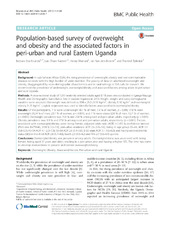| dc.description.abstract | Background In sub-Saharan Africa (SSA), the rising prevalence of overweight, obesity and non-communicable diseases co-exists with the high burden of under-nutrition. The paucity of data on adulthood overweight and obesity, disaggregated by socio-demographic characteristics and in rural settings in SSA calls for research. We determined the prevalence of underweight, overweight/obesity and associated factors among adults in peri-urban and rural Uganda. Methods A cross-sectional study of 1210 randomly selected adults aged ≥ 18 years was conducted in Iganga-Mayuge Health and Demographic Surveillance Site in eastern Uganda in 2013. Height, weight and socio-demographic variables were assessed. Overweight was defined as BMI = 25.0-29.99 kg/m2, obesity ≥ 30 kg/m2 and overweight/obesity ≥ 25 kg/m2. Logistic regression was used to identify factors associated with overweight/obesity. Results Of the participants, 7 % were underweight (8.1 % of men; 5.9 % of women, p = 0.99); 17.8 % were overweight (12.4 % of men; 23.1 % of women, p < 0.001); and 7 % were obese (2.0 % of men; 12.7 % of women, p < 0.001). Overweight prevalence was 15.8 % and 23.8 % among rural and peri-urban adults, respectively (p < 0.001). Obesity prevalence was 3.9 % and 17.8 % among rural and peri-urban adults, respectively (p < 0.001). Factors associated with overweight/obesity were: being female, adjusted odds ratio (AOR) 4.3 (95 % confidence interval (PloS one 8:e75640, 20013) 3.2–5.9); peri-urban residence AOR 2.6 (1.9–3.6); being in age group 35–44, AOR 3.1 (1.8–5.3); 45–54 AOR 4.1 (2.3–7.3); 55–64 AOR 2.6 (1.4–5.0); ≥ 65 years AOR 3.1 (1.6–6.0); and having socio-economic status (SES) in the third AOR 2.8 (1.7–4.6), fourth 2.5 (1.5–4.2) and fifth 2.7 (1.6–4.4) quintile. Conclusions Overweight/obesity was prevalent among adults. Overweight/obese was associated with being female, being aged 35 years and older, residing in a peri-urban area and having a higher SES. The time has come to develop interventions to prevent and control overweight/obesity. | en_US |

